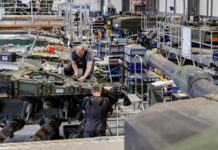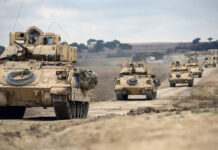An important feature of image processing is the comparison of new and stored images to detect changes over time. This method is called Coherent Change Detection (CCD) and its uses are rapidly spreading throughout the military. By comparing live images with past images of the same area, systems can automatically detect and identify changes which can show placement of new objects such as hidden IEDs, faint signatures of recent movement, such as vehicle tracks, changes in foliage indicating human movements, or application of camouflage that could indicate suspicious activity. Through the image analysis and investigative process, these views can be superimposed with thermal images, showing latent signatures of recent human activity. When searching for a specific type of object, hyperspectral analysis can be performed, by dedicated sensors, which are designed to identify specific traces of chemical or organic materials, by their distinctive spectral reflections.
Multi-spectral image fusing is also performed to enable target identification from very long range, particularly at night. For example, combining Near IR (NIR) with TV overcomes the visual reflection from a car windshield, to show people inside a car. Identifying these people from a long distance can be done by illuminating the target with an invisible laser beam, and using a special telescopic “gated CCD” sensor to view the target in great details.
Progress is also evident in solving the “bandwidth bottleneck”, transferring large files over communications networks. The US Marine Corps are planning to field the Video Storage Wide Area Network, which collects and provides information on situational awareness. The network uses multiple image collectors including Pioneer and ScanEagle UAVs. The ground stations of these UAVs are streaming live video over satellite communications to a central repository which provides digitization, compression, editing and storage services. These video databases are then made available to multiple users in theater as well as worldwide. While the system supports multiple users and multiple streams, bandwidth availability becomes an issue when 128K “pipes” are used – typical streaming video requires around 400-Kbps bandwidth, which is not always available for field users.
Additional parts of this article:





















